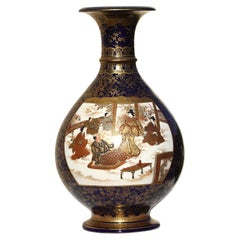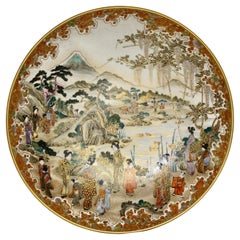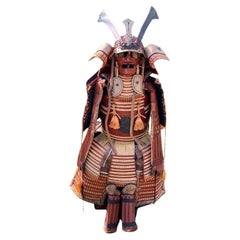Kinkozan Antiquities
to
2
2
1
1
2
2
2
2
10
4
3
2
2
Creator: Kinkozan
Japanese Satsuma Earthenware Vase by Kinkozan, Meiji Period
By Kinkozan
Located in West Palm Beach, FL
A Japanese Satsuma Earthenware Vase by Kinkozan, Meiji period (1868-1912)
The body inset with two panels, one depicting figures seated around a table, the other painted with a joyful scene in a shrine, all reserved on a blue ground decorated with a gilt flower pattern, signed Nihon Kyoto Kinkozan zo...
Category
20th Century Kinkozan Antiquities
Materials
Ceramic
An Earthenware Dish By Kinkozan, Meiji period, late 19th century
By Kinkozan
Located in West Palm Beach, FL
An earthenware dish
By Kinkozan, Meiji period, late 19th century
Painted in polychrome enamels and gilt over a clear crackled glaze with beauties and children enjoying a summer outing in a mountainous water landscape, the scene surrounded by a frame of blossoming flower heads,
signed in gilt Kinkozan zo...
Category
19th Century Antique Kinkozan Antiquities
Materials
Ceramic
Related Items
Japanese Red Samurai Armour Beginning of Meiji period 1900s
Located in Paris, FR
This is an armour of samurai. It was made around 1900s in Meiji era. This armour was not used in actual war so it was made as decoration, because of that, it is in good condition as its age.
There are some scratches and missing parts, if you need some more information, please let us know, we will respond you as soon as possible and send more photos.
This armour can be folded in a box. The box is getting damaged so it is not in good condition. We might send this armour in other box.
Dimensions: 50 x 50 x H170 cm
Scholars agree that Japanese armour first appeared in the 4th century, with the discovery of the cuirass and basic helmets in graves. During the Heian period, the unique Japanese samurai...
Category
Early 1900s Japanese Meiji Antique Kinkozan Antiquities
Materials
Metal, Iron
Japanese Meiji Period (1868-1912) Satsuma Earthenware Vase Taizan for Hattori
Located in Newark, England
Meiji Period (1868-1912)
From our Japanese collection, we are delighted to offer Japanese Meiji Period Satsuma Vases. The Satsuma Vase of hexagonal form with a slight waisted neck and tight rounded rim is extensively decorated with multiple figures to two large scenes. The first scene features a beach with waves to the background and a plethora of figures including multiple geisha holding traditional Japanese wagasa’s. The second scene follows on from the first with a large building in the foreground holding figures on a large platform under a pagoda roof with a pagoda building in the background and further figures in the foreground. The scenes are framed by a full detailed border with gilt shapes, flowers amongst pink shaded backgrounds and butterflies around the neck. The Satsuma Vase is unusually signed Fine Art, Satsuma Ware, Dai Nippon (Great Japan), Hattori Made, Gosuido Works, Taizan Painted. 美術, サツマヤキ(薩摩焼), 大日本, 服部造, 五スイ堂工, 對山画 and dates to the Meiji Period (1868-1912) and the turn of the 20th century circa 1905.
Satsuma ware is a type of earthenware pottery originating from the Satsuma province in Southern Kyushu, Japan’s third largest island.
Wagasa are traditional Japanese umbrellas made of washi paper attached to a bamboo frame and treated to ensure it is waterproof.
Meiji Period was an era of Japanese history that spanned from 1868 to 1912. It was the first half of the Empire of Japan, when the Japanese people began to build a paradigm of a modern, industrialised nation state and emergent great power, influenced by Western countries and aesthetics. As a result of radically different ideas, the changes to Japan were profound and it affected the social structure, politics, economy, military, and foreign relations across the board. The period corresponded to the reign of Emperor Meiji and was preceded by the Keio era and was succeeded by the Taisho era.
Cultural Art during the Meiji Period was of particular interest to the government and they overhauled the art export market which in turn promoted Japanese arts via various world’s fairs, beginning in Vienna at the world fair in 1873. The government heavily funded the fairs and took an active role organising how Japan’s culture was presented to the world including creating a semi-public company named Kiritsu Kosho Kaisha (First Industrial Manufacturing Company). The Kiritsu Kosho Kaisha was used to promote and commercialise exports of Japanese art and established the Hakurankai Jimukyoku (Exhibition Bureau) to maintain quality standards. For the 1876 Centennial International Exhibition in Philadelphia, the Japanese government created a Centennial Office and sent a special envoy to secure space for the 30,000 items that would be displayed. The Imperial Household also took an active interest in arts and crafts, commissioning works by select artists to be given as gifts for foreign dignitaries further emphasising the high quality and importance of Japanese art. Just before the end of the 19th century in 1890, the Teishitsu Gigeiin (Artist to the Imperial Household) system was created to recognise distinguished artists. These artists were selected for their exceptionally high quality wares and talent in their own industry. Over a period of 54 years Seventy artists were appointed, amongst these were ceramicist Makuzu Kozan and cloisonné enamel artist...
Category
Early 1900s Japanese Meiji Antique Kinkozan Antiquities
Materials
Earthenware, Pottery
$3,134
H 4.63 in W 2.17 in D 2.37 in
19th Century, Meiji, Antique Japanese Ceramic Jar
Located in Sampantawong, TH
Antique Japanese ceramic jar.
Age: Japan, Meiji Period, 19th century
Size: Height 34 C.M. / Width 46.2 C.M.
Condition: Nice condition overall.
100% satisfaction and authenticity guaranteed...
Category
19th Century Japanese Antique Kinkozan Antiquities
Materials
Ceramic
Japanese Meiji Period (1868-1912) Satsuma Vase by Kinkozan
By Kinkozan
Located in Newark, England
JAPANESE SATSUMA PROCESSIONAL VASE
From our Japanese collection, we are delighted to introduce to the market this Japanese Satsuma Vase by Kinkozan. The vase with a compressed body ...
Category
Late 19th Century Japanese Meiji Antique Kinkozan Antiquities
Materials
Ceramic, Earthenware, Pottery
A Fine Japanese Satsuma Vase . Meiji Period. Kinkozan
Located in London, GB
A Fine Japanese Satsuma Vase with Bijin, Peacock, and Chrysanthemums.
Attributed to Kinkozan Workshop, Kyoto, Meiji period (late 19th century)
Of pear-shaped form with a flared f...
Category
19th Century Japanese Antique Kinkozan Antiquities
Materials
Ceramic, Porcelain
A Fine Japanese Satsuma vase signed by Ryokuzan. Meiji period
Located in London, GB
A exquisite Satsuma vase signed by Ryokuzan.
Meiji Era.
Of a slender ovoid shape featuring intricate hand-painted designs and delicate gilded accents.
The vase is adorned with...
Category
19th Century Japanese Antique Kinkozan Antiquities
Materials
Ceramic, Porcelain
Japanese Satsuma Dragon Vase, Meiji Period, c 1900, Japan
By Satsuma
Located in Austin, TX
A fantastic small Japanese Satsuma vase with image of writhing dragons, Meiji Period, circa 1900, Japan.
The vase of elegant baluster form, with a slightly flared foot, slender body...
Category
Early 1900s Japanese Meiji Antique Kinkozan Antiquities
Materials
Ceramic, Porcelain, Pottery, Stoneware, Hardwood
Unusual Pair of Japanese Meiji Period (1868-1912) Satsuma Vases by Kinkozan
By Kinkozan
Located in Newark, England
Taizan Yohei IX Style
From our Japanese collection we are delighted to offer this pair of Japanese Satsuma Vases by Kinkozan. The Satsuma Vases of baluster shape made from earthenwa...
Category
Early 1900s Japanese Meiji Antique Kinkozan Antiquities
Materials
Ceramic, Earthenware, Pottery
$5,723
H 9.45 in Dm 4.93 in
Satsuma earthenware vase by kinkozan, Meiji period
By Kinkozan
Located in Tel Aviv - Jaffa, IL
the body of this small marvelous vase is painted with a scene of a puppet show vendor with his wood backpack, on top of the backpack there are toys and dolls, he is surrounded with a group of 6 children, and on the background you can see a village.
on the other side of the vase there is an amazing painting of flowers and on the sides there are two amazing strong pine trees, the amorphous background is decorated in a "Tortoiseshell" color and design that gives it a real character and which is quite rare to see on satsuma pottery.
all the vase is over richly overpainted over the glaze with gold, which gives it its depth and realism.
signed Kyoto Kinkozan zo, and sealed Kinkozan zo
Kyoto’s Satsuma:
The painting technique used in Kyoto’s Satsuma-style ware is said to be the invention of the sixth generation Kinkōzan Sōbei (1824–1884). The Kinkōzan were a famous family of Kyoto Awataguchi potters who made ceramics that were used at Shōren'in, a temple closely tied to the imperial family, and by the shoguns of the Edo government. In fact the shogun is said to have granted them the name Kinkōzan. With the upheavals at the end of the Edo period, however, and the reforms of the subsequent Meiji government, the potters lost their traditional patrons and had to develop new markets.
Just at that time, the visit of a certain Westerner is said to have decided them to embark on overseas trade. By 1870, they had perfected Kyō Satsuma...
Category
1890s Japanese Meiji Antique Kinkozan Antiquities
Materials
Gold
Cloisonné Vase, Qing Period, 19th Century
Located in seoul, KR
Cloisonné enamel vase of baluster form and lobed sides decorated with foliage and flowers on a black background, gilt copper neck and base. Around 1900
Period: Qing Dynasty
Type: Va...
Category
19th Century Hong Kong Qing Antique Kinkozan Antiquities
Materials
Enamel
Late 19th Century Elmwood Console China Export
Located in Brescia, IT
This elegant elmwood console is handcrafted and so the beautiful details under the top and to the corners, both the sides. This is a piece of glamorous timeless
The top is in solid...
Category
Late 19th Century Chinese Chinese Export Antique Kinkozan Antiquities
Materials
Elm
$3,585 Sale Price
20% Off
H 33.47 in W 70.48 in D 14.18 in
19th Century, Meiji, Antique Japanese Wooden Noh Mask
Located in Sampantawong, TH
Antique Japanese wooden Noh mask.
Age: Japan, Meiji Period, 19th Century
Size: Length 20 C.M. / Width 13.9 C.M. / Thickness 8 C.M.
Condition: Nice condition overall (some expected d...
Category
19th Century Japanese Antique Kinkozan Antiquities
Materials
Wood
$1,320 Sale Price
20% Off
H 3.15 in W 7.88 in D 5.48 in
Kinkozan antiquities for sale on 1stDibs.
Kinkozan antiquities are available for sale on 1stDibs. These distinctive items are frequently made of ceramic and are designed with extraordinary care. There are many options to choose from in our collection of Kinkozan antiquities, although brown editions of this piece are particularly popular. Prices for Kinkozan antiquities can differ depending upon size, time period and other attributes — on 1stDibs, these items begin at $2,500 and can go as high as $7,500, while a piece like these, on average, fetch $5,500.



